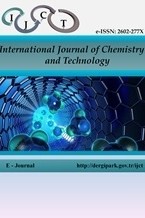Enhancing the adsorption of disinfection by-products onto activated carbon using TiO2 nanoparticles
Enhancing the adsorption of disinfection by-products onto activated carbon using TiO2 nanoparticles
Disinfection by-products, drinking water nanoparticles TiO2, THMs,
___
- 1. Rakness, K. L. Ozone in drinking water treatment: process design, operation, and optimization, 1st ed.; American Water Works Association, Colorado, USA, 2005.
- 2. Alexandrou, L.; Meehan, B. J.; Jones, O. A. Sci. Total Environ. 2018, 637, 1607-1616.
- 3. Selvam, R.; Muniraj, S.; Duraisamy, T.; Muthunarayanan, V. Appl. Water Sci. 2018, 8 (5):135.
- 4. Fakour, H.; Lo, S. L. Sci. Rep. 2018, 8(1), 5709.
- 5. Tak, S.; Vellanki, B. P. J. Water Health 2018, 16(5), 681-703.
- 6. Sharma, A.; Ahmad, J.; Flora, S. J. S. Environ. Res. 2018, 167, 223-233.
- 7. Deb, A. Photocatalytic degradation of Benzophenone 3 in aqueous media under UV light irradiation. Master’s Thesis, Lappeenranta University of Technology School of Engineering Science, Finland, 2018.
- 8. Dong, R.; Cai, Y.; Yang, Y.; Gao, W.; Ren, B. Accounts Chem. Res. 2018, 51(9), 1940-1947.
- 9. Gora, S. L.; Andrews, S. A. Chemosphere 2019, 218, 52-63.
- 10. US EPA, Method 551. Determination of chlorination disinfection by-products and chlorinated solvents in drinking water by liquid-liquid extraction and gas chromatography with electron-capture detection, Environmental Monitoring Systems Laboratory, Office of Research and Development, Cincinnati, 1990.
- 11. Toroz, I.; Uyak, V. Desalination 2005, 176 (1-3),
- 12. Flickinger, B.; Hinshaw, J. V. GC instruments and accessories at the 54th Pittsburgh Conference. LC-GC: magazine of liquid and gas chromatography, 21 (5), 446-457, North America, 2003, 127-141.
- 13. Saini, H. K. U.S. Patent No. 9,903,844. Washington, DC: U.S. Patent and Trademark Office, 2018.
- 14. Andersson, A.; Ashiq, M. J.; Shoeb, M.; Karlsson, S.; Bastviken, D.; Kylin, H. Environ. Sci. Pollut. R. 2019, 26 (8), 7305-7314.
- Yayın Aralığı: Yılda 2 Sayı
- Başlangıç: 2017
- Yayıncı: İbrahim DEMİRTAŞ
Enhancing the adsorption of disinfection by-products onto activated carbon using TiO2 nanoparticles
Stress behaviours of viscoelastic flow around square cylinder
Guler Bengusu TEZEL, Kerim YAPICI, Yusuf ULUDAG
Rapid isolation of rosmarinic acid from Ocimum basilicum using flash chromatography
Hüseyin AKŞİT, Mehmet KEÇECİ, İbrahim DEMİRTAŞ, Nusret GENÇ
Mehmet Salih AĞIRTAŞ, Cihan DURMUŞ, Beyza CABİR
A corrosion study: Use of Thionine dye having structurally metachromatic influence
Optimization, isotherm and kinetics studies of azo dye adsorption on eggshell membrane
Ayşe DİNÇER, Mervecan SEVİLDİK, Tülin AYDEMİR
Gül KOTAN, Bedrettin SAVAŞ, Haydar YÜKSEK
A study on leaching kinetics of chalcopyrite in KNO3 + H2SO4 medium
